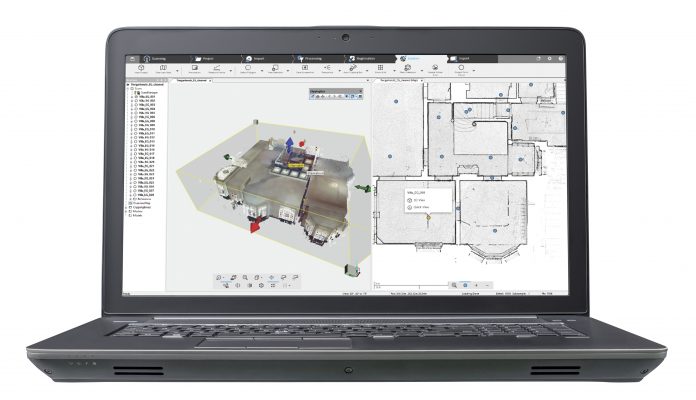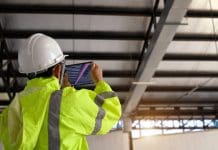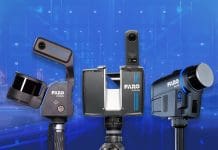While 2020 was no doubt a challenging year, there were some decidedly sunny breaks, says Jerry Hardy, integrated marketing director, architecture engineering and construction, FARO Technologies
One of the brightest spots came through technology, specifically remote collaboration and the sharing of digital data.
For the public, that sharing came through videoconferencing. Key to the technologies’ success is the seamless and instantaneous exchange of information, especially the ability to collaborate faster and safer with documents, shared screens and real-time chat functionality.
It’s a digital transformation not lost on AEC professionals. Just as Zoom, Microsoft Teams and Google Meet have transformed sharing digital data, cloud-based reality capture is having a similar effect on the AEC industry, leading to more accurate and secure information shared with project stakeholders anywhere in the world – meaning faster decisions with less error.
The winds of change
To be sure, reality capture – a technology that converts physical assets into millions of X, Y, Z coordinate data, and with software assistance, registers that data into 3D models – is nothing new. But neither is videoconferencing. Each platform capitalises on the current moment as newfound need drives newfound innovation. For AEC professionals, the ‘innovation’ happens when the technology merges with cloud-based data sharing.
FARO’s Focus Swift is an example of the laser scanning component of the technology at work. As the first fully integrated indoor 3D mobile mapping solution, Swift accomplishes large-area as-built capturing tasks with minimal time and effort, providing better data faster, and is ideal for indoor scans of factories, office buildings, hospitals and retail shops.
Depending on accuracy requirements, the device can scan large, complex areas up to 10 times faster than traditional static scans, while allowing users to directly import in any CAD system with 3D point cloud capabilities, optimising their scan-to-BIM workflows. Unlike traditional surveying tools prone to human error and manual delays, 3D laser scanning produces a highly accurate digital replica of the physical asset in record time.
Get your head in the cloud
Of course, none of this innovation would be possible without the world’s digital infrastructure. Only a few years ago, the ability to handle high-volume data like that contained in a reality capture project (an entire point cloud can contain gigabytes to terabytes of information) did not exist. And what did exist in terms of internet connectivity, reached fewer people. Hand delivery or mailing of physical data storage devices was common.
Today, according to cloud software firm DOMO, the internet reaches more than half of the global population and Americans alone use 4.4m gigabytes of data every minute of every day. Considering the extreme increase in remote working (as well as ongoing IoT proliferation), it’s likely these numbers have only increased.
Thus, for businesses large and small (but especially those working on construction projects that span long distances where travel would be cost prohibitive or unsafe), cloud-based reality capture sharing offers numerous benefits. The five largest include: efficiency, precision, protection, savings and trust.
Efficiency: Instead of spending money to send multiple project managers to a construction site to take manual measurements, only a skeleton crew is required for that same initial effort. And once the laser scan is taken the first time, there’s no need to return to the physical site as all measurements have been taken accurately the first time.
Precision: Laser scanning generates fast and accurate results, transforming a landscape or a building into a detailed 3D model. For instance, ground-based LIDAR (Laser Imaging Detection and Ranging) can yield results accurate to within millimetre scale.
Protection: In the Covid and post-Covid world, we have all become sensitive to pathogenic threats. While extreme social distancing measures are likely to be relaxed in the coming months, remote working and remote sharing of reality capture will continue.
Savings: Because of the greater precision involved, project budgeting becomes more effective. It also means that surplus financial resources can be diverted to additional projects. And since each project is completed faster, there’s a net positive in attracting, retaining and engaging new business.
Trust: Long-term client buy-in has an additional positive externality: trust. Not just trust in your specific brand, but in the AEC industry at large. These are challenging times. And safety – in all its variety – is more important than ever. As the industry continues to make the cloud-based reality capture transition, adoption of the technology benefits all.
An encouraging long-range forecast
As a growing number of construction managers, field operators and the like look to enhance safety and bolster remote collaboration work (saving time, money and energy in the process), cloud-based reality data sharing will only expand in importance.
FARO’s WebShare Software, which offers real-time access to the latest reality data for worldwide project management and BIM workflows, is an example of that growth. Capable of supporting 3D reality data of unlimited size, independent of its source of data capture, the data can be viewed, evaluated and shared only from authorised persons, anywhere, at any time, via the web. And by working with common industry standard formats, WebShare enables seamless and collaborative Scan-to-BIM workflows.
Thus, with WebShare – and solutions like it – scanning service providers, construction managers, as well as facility, plant and asset managers can exchange reality data with engineers, architects or other project partners to collaborate with ease despite working in different locations around the world.
While it’s true 2021 likely has some unsettled patches ahead, cloud-based reality capture is proving its worth.
Now that’s a sunny forecast all parties can embrace.
Regional
FARO UK
Tel: +49 (0)7150 9797 – 400
Twitter: @faroeurope
Please note: this is a commercial profile.














